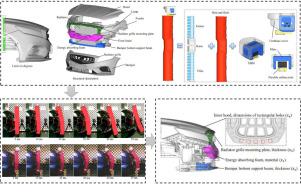Thin-Walled Structures ( IF 6.4 ) Pub Date : 2021-07-28 , DOI: 10.1016/j.tws.2021.108087 Fei Lei 1 , Xiaojiang Lv 1, 2 , Jianguang Fang 3 , Tong Pang 1 , Qing Li 4 , Guangyong Sun 1

|
Lower extremity is the most frequently injured body region in a pedestrian–vehicle impact. To evaluate lower extremity injuries, both the Flexible Pedestrian Legform Impactor (FlexPLI) and the Flexible Pedestrian Legform Impactor with Upper Body Mass (FlexPLI-UBM) have been used in practice. In general, UBM would have considerable influence on the design of front-end structures. In this study, a sedan was used to perform the experimental tests first for evaluating the effects of different lower extremities. The experimental results indicated that placement of UBM can lead to a higher risk evaluation of knee ligament damage and a more significant increase in femur bending moment than that in tibia bending moment. Second, a new multiobjective discrete robust optimization (MODRO) algorithm was developed to optimize front-end structures subject to FlexPLI-UBM impact involving uncertainties. In the proposed MODRO algorithm, the order preference by similarity to ideal solution (TOPSIS) was coupled with the fuzzy approach for developing a fuzzy multiple attribute decision making (MADM) model for converting multiple conflicting objectives into a single unified cost function. The presented optimization procedure is iterated using the successive orthogonal experiment to deal with a large number of design variables and design levels. The optimal results showed that in contrast to the structures subject to the FlexPLI impact, the front-end structures under FlexPLI-UBM impact require a higher stiffness of tibia contact area but a lower stiffness of knee and femur contact area. This study provides automotive engineers with new insights into the injury biomechanics-based design of frontal structure from a road safety perspective.
中文翻译:

基于损伤生物力学的前端结构非确定性优化以确保行人车辆碰撞安全
下肢是行人与车辆碰撞中最常受伤的身体部位。为了评估下肢损伤,在实践中使用了灵活的行人腿部撞击器 (FlexPLI) 和具有上身质量的柔性行人腿部撞击器 (FlexPLI-UBM)。一般来说,UBM 会对前端结构的设计产生相当大的影响。在这项研究中,首先使用轿车进行实验测试,以评估不同下肢的影响。实验结果表明,与胫骨弯矩相比,UBM 的放置可以导致更高的膝关节韧带损伤风险评估和更显着的股骨弯矩增加。第二,开发了一种新的多目标离散鲁棒优化 (MODRO) 算法,以优化受 FlexPLI-UBM 影响(涉及不确定性)的前端结构。在所提出的 MODRO 算法中,通过与理想解决方案相似的顺序偏好 (TOPSIS) 与模糊方法相结合,以开发模糊多属性决策 (MADM) 模型,以将多个相互冲突的目标转换为单个统一成本函数。所提出的优化程序使用连续正交试验进行迭代,以处理大量设计变量和设计水平。最佳结果表明,与受到 FlexPLI 冲击的结构相比,FlexPLI-UBM 冲击下的前端结构需要较高的胫骨接触区刚度,但需要较低的膝盖和股骨接触区刚度。这项研究从道路安全的角度为汽车工程师提供了基于损伤生物力学的正面结构设计的新见解。


























 京公网安备 11010802027423号
京公网安备 11010802027423号